A Comparative Study on Land Use/Land Cover Change and Topographic Gradient Effect between Mountains and Flatlands of Southwest China
Abstract
:1. Introduction
2. Materials and Methods
2.1. Study Area
2.2. Data Source and Processing
2.3. Methods
2.3.1. Transfer Chord Diagram and Evolution Characteristic Map
2.3.2. Terrain Position Index
2.3.3. Distribution Index
2.3.4. Diversity Index
3. Results
3.1. Characteristics of LULC Change
3.1.1. Spatial Distribution of LULC
3.1.2. Analysis of LULC Changes
3.2. Topographic Characteristics and Terrain Gradient Distribution of LULC
3.2.1. Topographic Features in the Study Area
3.2.2. Land Use Distribution Index on Topographic Gradient in Mountains
3.2.3. Land Use Distribution Index on Topographic Gradient in Flatlands
3.3. Land Use Type Diversity on Topographic Gradient
4. Discussion
4.1. The Forming Causation of Diferences
4.2. Limitations and Future Study
5. Conclusions
Author Contributions
Funding
Data Availability Statement
Acknowledgments
Conflicts of Interest
Appendix A
| Year | Types | CL | GL | FL | WL | WB | BL |
|---|---|---|---|---|---|---|---|
| 2000 | Area (hm2) | 286,797.19 | 96,411.58 | 774,316.12 | 37.80 | 7939.09 | 2861.68 |
| Proportion (%) | 24.55 | 8.25 | 66.27 | 0.00 | 0.68 | 0.24 | |
| 2010 | Area (hm2) | 294,986.67 | 106,123.59 | 756,017.65 | 256.57 | 7339.49 | 3639.82 |
| Proportion (%) | 25.25 | 9.08 | 64.71 | 0.02 | 0.63 | 0.31 | |
| 2020 | Area (hm2) | 290,004.86 | 106,211.13 | 753,703.94 | 219.70 | 7682.05 | 10,543.28 |
| Proportion (%) | 24.82 | 9.09 | 64.51 | 0.02 | 0.66 | 0.90 |
| Year | Types | CL | GL | FL | WL | WB | BL |
|---|---|---|---|---|---|---|---|
| 2000 | Area (hm2) | 112,534.91 | 53,360.99 | 125,161.70 | 171.19 | 28,223.11 | 8391.10 |
| Proportion (%) | 34.33 | 16.28 | 38.18 | 0.05 | 8.61 | 2.56 | |
| 2010 | Area (hm2) | 108,536.75 | 56,886.83 | 126,881.71 | 284.12 | 26,574.46 | 8681.73 |
| Proportion (%) | 33.11 | 17.35 | 38.70 | 0.09 | 8.11 | 2.65 | |
| 2020 | Area (hm2) | 100,666.40 | 52,911.22 | 123,547.81 | 277.63 | 27,374.26 | 23,063.47 |
| Proportion (%) | 30.71 | 16.14 | 37.69 | 0.08 | 8.35 | 7.03 |
| Types | CL | GL | FL | WL | WB | BL | Transfer-Out Area (hm2) | Transfer-Out Proportion (%) |
|---|---|---|---|---|---|---|---|---|
| CL | – | 4597.81 | 18,628.37 | 40.30 | 321.49 | 948.40 | 24,536.37 | 26.28 |
| GL | 9891.24 | – | 9286.15 | 69.35 | 142.75 | 174.56 | 19,564.03 | 20.95 |
| FL | 21,894.89 | 24,416.69 | – | 103.30 | 567.96 | 140.41 | 47,123.26 | 50.47 |
| WL | 5.83 | 2.44 | 3.46 | – | 4.03 | 0.07 | 15.83 | 0.02 |
| WB | 515.54 | 232.46 | 867.07 | 21.61 | – | 1.91 | 1638.60 | 1.76 |
| BL | 417.32 | 26.95 | 39.02 | 0.00 | 4.11 | – | 487.40 | 0.52 |
| Transfer-in area (hm2) | 32,724.81 | 29,276.36 | 28,824.07 | 234.56 | 1040.35 | 1265.35 | 93,365.51 | 100.00 |
| Transfer-in proportion (%) | 35.05 | 31.36 | 30.87 | 0.25 | 1.11 | 1.36 | 100.00 |
| Types | CL | GL | FL | WL | WB | BL | Transfer-Out Area (hm2) | Transfer-Out Proportion (%) |
|---|---|---|---|---|---|---|---|---|
| CL | – | 5216.37 | 15,047.19 | 17.99 | 402.81 | 4588.65 | 25,273.02 | 31.19 |
| GL | 4923.87 | – | 14,644.41 | 4.49 | 214.53 | 1627.54 | 21,414.85 | 26.43 |
| FL | 14,567.22 | 16,089.46 | – | 3.76 | 585.96 | 1379.48 | 32,625.88 | 40.27 |
| WL | 15.31 | 4.50 | 9.13 | – | 56.75 | 0.00 | 85.70 | 0.11 |
| WB | 224.61 | 110.98 | 552.89 | 22.91 | – | 9.31 | 920.70 | 1.14 |
| BL | 559.18 | 81.83 | 59.13 | 0.00 | 1.35 | – | 701.49 | 0.87 |
| Transfer-in area (hm2) | 20,290.20 | 21,503.14 | 30,312.75 | 49.15 | 1261.41 | 7604.98 | 81,021.64 | 100.00 |
| Transfer-in proportion (%) | 25.04 | 26.54 | 37.41 | 0.06 | 1.56 | 9.39 | 100.00 | – |
| Types | CL | GL | FL | WL | WB | BL | Transfer-Out Area (hm2) | Transfer-Out Proportion (%) |
|---|---|---|---|---|---|---|---|---|
| CL | – | 4722.22 | 22,706.77 | 48.33 | 456.95 | 5011.38 | 32,945.66 | 27.93 |
| GL | 10,431.39 | – | 12,940.87 | 39.56 | 232.88 | 1762.87 | 25,407.57 | 21.54 |
| FL | 24,702.73 | 30,176.16 | – | 87.91 | 732.10 | 1547.74 | 57,246.63 | 48.53 |
| WL | 6.69 | 2.71 | 3.07 | – | 3.05 | 0.05 | 15.58 | 0.01 |
| WB | 476.51 | 225.72 | 939.12 | 21.66 | – | 23.83 | 1686.84 | 1.43 |
| BL | 534.55 | 82.04 | 43.00 | 0.00 | 4.73 | – | 664.31 | 0.56 |
| Transfer-in area (hm2) | 36,151.87 | 35,208.85 | 36,632.84 | 197.45 | 1429.71 | 8345.88 | 117,966.59 | 100.00 |
| Transfer-in proportion (%) | 30.65 | 29.85 | 31.05 | 0.17 | 1.21 | 7.07 | 100.00 | – |
| Types | CL | GL | FL | WL | WB | BL | Transfer-Out Area (hm2) | Transfer-Out Proportion (%) |
|---|---|---|---|---|---|---|---|---|
| CL | – | 3218.24 | 3416.38 | 1.19 | 226.21 | 899.15 | 7761.18 | 34.86 |
| GL | 1175.36 | – | 3860.75 | 0.04 | 6.65 | 22.73 | 5065.53 | 22.75 |
| FL | 1404.04 | 5061.17 | – | 1.69 | 116.76 | 25.74 | 6609.40 | 29.69 |
| WL | 90.07 | 5.02 | 65.35 | – | 4.10 | 0.16 | 164.69 | 0.74 |
| WB | 593.23 | 245.11 | 887.12 | 274.70 | – | 2.60 | 2002.76 | 9.00 |
| BL | 496.03 | 60.61 | 102.46 | 0.00 | 0.65 | – | 659.74 | 2.96 |
| Transfer-in area (hm2) | 3758.72 | 8590.15 | 8332.06 | 277.62 | 354.37 | 950.37 | 22,263.30 | 100.00 |
| Transfer-in proportion (%) | 16.88 | 38.58 | 37.43 | 1.25 | 1.59 | 4.27 | 100.00 | – |
| Types | CL | GL | FL | WL | WB | BL | Transfer-Out Area (hm2) | Transfer-Out Proportion (%) |
|---|---|---|---|---|---|---|---|---|
| CL | – | 2028.72 | 1430.96 | 17.34 | 273.04 | 9646.02 | 13,396.08 | 43.75 |
| GL | 3462.43 | – | 2773.40 | 2.46 | 144.46 | 2531.94 | 8914.69 | 29.11 |
| FL | 1731.95 | 2887.94 | – | 108.16 | 433.45 | 2486.29 | 7647.79 | 24.98 |
| WL | 0.82 | 0.05 | 2.21 | – | 150.20 | 0.00 | 153.27 | 0.50 |
| WB | 74.53 | 8.48 | 86.20 | 18.82 | – | 18.22 | 206.25 | 0.67 |
| BL | 257.65 | 13.66 | 24.58 | 0.00 | 5.23 | – | 301.12 | 0.98 |
| Transfer-in area (hm2) | 5527.38 | 4938.85 | 4317.36 | 146.78 | 1006.38 | 14,682.47 | 30,619.20 | 100.00 |
| Transfer-in proportion (%) | 18.05 | 16.13 | 14.10 | 0.48 | 3.29 | 47.95 | 100.00 | – |
| Types | CL | GL | FL | WL | WB | BL | Transfer-Out Area (hm2) | Transfer-Out Proportion (%) |
|---|---|---|---|---|---|---|---|---|
| CL | – | 3668.33 | 2831.26 | 9.44 | 386.60 | 11,903.15 | 18,798.77 | 46.91 |
| GL | 3732.12 | – | 4132.50 | 0.67 | 44.69 | 1822.91 | 9732.88 | 24.29 |
| FL | 2098.57 | 5422.75 | – | 29.02 | 199.86 | 1489.95 | 9240.14 | 23.06 |
| WL | 78.71 | 4.18 | 47.48 | – | 17.35 | 15.98 | 163.71 | 0.41 |
| WB | 494.56 | 149.90 | 552.08 | 231.01 | – | 76.22 | 1503.77 | 3.75 |
| BL | 524.03 | 36.52 | 68.82 | 0.00 | 6.96 | – | 636.34 | 1.59 |
| Transfer-in area (hm2) | 6927.98 | 9281.68 | 7632.14 | 270.14 | 655.46 | 15,308.21 | 40,075.61 | 100.00 |
| Transfer-in proportion (%) | 17.29 | 23.16 | 19.04 | 0.67 | 1.64 | 38.20 | 100.00 | – |
| Change Types | Area (hm2) | Proportion (%) |
|---|---|---|
| Stable | 1,024,940.08 | 87.74 |
| Early change | 62,158.31 | 5.32 |
| Late change | 49,812.49 | 4.26 |
| Continuous change | 5972.17 | 0.51 |
| Recurrent change | 25,218.14 | 2.16 |
| Change Types | Area (hm2) | Proportion (%) |
|---|---|---|
| Stable | 282,838.68 | 86.29 |
| Early change | 14,328.74 | 4.37 |
| Late change | 22,684.31 | 6.92 |
| Continuous change | 3058.75 | 0.93 |
| Recurrent change | 4873.73 | 1.49 |
| Topographic Index | Grade | I | II | III | IV | V |
|---|---|---|---|---|---|---|
| Elevation | Area (hm2) | 14,437.10 | 140,901.25 | 1,022,170.92 | 317,957.94 | 126.08 |
| Proportion (%) | 0.97 | 9.42 | 68.35 | 21.26 | 0.01 | |
| Slope | Area (hm2) | 50,503.28 | 131,396.58 | 440,079.70 | 504,090.16 | 366,055.63 |
| Proportion (%) | 3.38 | 8.81 | 29.49 | 33.78 | 24.53 | |
| Relief | Area (hm2) | 45,424.43 | 174,840.57 | 936,492.90 | 453,406.61 | 5485.81 |
| Proportion (%) | 2.81 | 10.82 | 57.96 | 28.06 | 0.34 | |
| Terrain position | Area (hm2) | 113,470.07 | 299,128.09 | 447,219.14 | 428,743.96 | 203,202.10 |
| Proportion (%) | 7.61 | 20.05 | 29.98 | 28.74 | 13.62 |
References
- Smiraglia, D.; Ceccarelli, T.; Bajocco, S.; Perini, L.; Salvati, L. Unraveling landscape complexity: Land use/land cover changes and landscape pattern dynamics (1954–2008) in contrasting peri-urban and agro-forest regions of Northern Italy. Environ. Manag. 2015, 56, 916–932. [Google Scholar] [CrossRef] [PubMed]
- Chen, F.; Bai, X.Y.; Liu, F.; Luo, G.J.; Tian, Y.C.; Qin, L.Y.; Li, Y. Analysis long-term and spatial changes of forest cover in typical karst areas of China. Land 2022, 11, 1349. [Google Scholar] [CrossRef]
- Xiao, B.Q.; Bai, X.Y.; Zhao, C.W.; Tan, Q.; Li, Y.B.; Luo, G.J.; Wu, L.H.; Chen, F.; Li, C.J.; Ran, C.; et al. Responses of carbon and water use efficiencies to climate and land use changes in China’s karst areas. J. Hydrol. 2023, 617, 128968. [Google Scholar] [CrossRef]
- Zhang, Z.M.; Huang, X.F.; Zhou, Y.C. Spatial heterogeneity of soil organic carbon in a karst region under different land use patterns. Ecosphere 2020, 11, e03077. [Google Scholar] [CrossRef] [Green Version]
- Olorunfemi, I.E.; Fasinmirin, J.T.; Olufayo, A.A.; Komolafe, A.A. GIS and remote sensing-based analysis of the impacts of land use/land cover change (LULCC) on the environmental sustainability of Ekiti State, southwestern Nigeria. Environ. Dev. Sustain. 2020, 22, 661–692. [Google Scholar] [CrossRef]
- Wang, Q.M.; Yang, K.; Xu, Q.L.; Gao, R. Topographic gradient effect of land use change map in Dianchi Basin. Res. Soil Water Conserv. 2018, 25, 238–244. [Google Scholar]
- Zhang, J.; Ren, Z.Y. Spatiotemporal pattern and terrain gradient effect of land use change in Qinling-Bashan mountains. Trans. Chin. Soc. Agric. Eng. 2016, 32, 250–257. [Google Scholar]
- Dai, Y.Z.; Li, J.F. Terrain gradient effect of spatiotemporal evolution of ecological land and ecosystem service value in Dongting Lake Area. Res. Soil Water Conserv. 2018, 25, 197–204. [Google Scholar]
- Zhou, R.R.; Peng, P.; Zhou, G.H.; Tang, C.L.; Liu, X.H. Analysis of poverty characteristics and poverty influencing factors in different terrain areas. Trans. Chin. Soc. Agric. Eng. 2019, 35, 253–261. [Google Scholar]
- Lauer, W. Human development and environment in the Andes: A geoecological overview. Mt. Res. Dev. 1993, 13, 157–166. [Google Scholar] [CrossRef]
- Zhao, Y.Z.; Cao, J.N.; Zhang, X.D.; He, G.B. Topographic gradient effect and spatial pattern of land use in Baota District. Arid. Land Geogr. 2020, 43, 1307–1315. [Google Scholar]
- Zhang, L.; Wang, P.; Duan, X.; Zhao, Z.J. Terrain gradient effect and spatial structure characteristics of land use in Dashanbao area. Bull. Soil Water Conserv. 2022, 42, 315–321. [Google Scholar]
- Li, P.J.; Zuo, D.P.; Xu, Z.X.; Gao, X.X. Land use/cover and landscape patterns based on terrain in the Yarlung Tsangpo River basin, China. Mt. Res. 2022, 40, 136–150. [Google Scholar]
- Yang, Y.L.; Ma, M.G.; Zhou, Z.Y. Research on land use patterns and temporal and spatial evolution in mountainous watershed based on topographic gradient. Eng. Surv. Mapp. 2017, 26, 8–16. [Google Scholar]
- Shi, Y.; Han, R.; Guo, L. Temporal–spatial distribution of ecosystem health and its response to human interference based on different terrain gradients: A case study in Gannan, China. Sustainability 2020, 12, 1773. [Google Scholar] [CrossRef] [Green Version]
- Xiong, L.; Bai, X.Y.; Zhao, C.W.; Li, Y.B.; Tan, Q.; Luo, G.J.; Wu, L.H.; Chen, F.; Li, C.J.; Ran, C.; et al. High-resolution datasets for global carbonate and silicate rock weathering carbon sinks and their change trends. Earth’s Future 2022, 10, e2022EF002746. [Google Scholar] [CrossRef]
- Wang, Q.M.; Yang, K.; Li, L.X.; Zhu, Y.H. Assessing the terrain gradient effect of landscape ecological risk in the Dianchi Lake Basin of China Using Geo-Information Tupu Method. Int. J. Environ. Res. Public Health 2022, 19, 9634. [Google Scholar] [CrossRef]
- Liao, Y.M.; Yin, L.J.; Lan, A.J.; Zhai, X.; Shi, H.J.; Zhang, Y.B.; Zhong, J.S. Analysis of terrain gradient effect on land use change under different landforms in poor mountainous areas of northwest Guizhou. Ecol. Sci. 2023, 42, 111–118. [Google Scholar]
- Zhai, X.; Lan, A.J.; Liao, Y.M.; Mao, C.Y.; Zhong, J.S. Influence of terrain gradient on the spatio-temporal characteristics of land use pattern: Taking Bijie City as an example. J. Natrual Sci. Hunan Norm. Univ. 2022, 45, 70–80. [Google Scholar]
- Zhang, H.; Li, Y.B. Coupling and coordinated evolution between land-use and landscape in mountain-basin system in the context of rural transformation: A case study of six mountain-basin systems in Guizhou province, China. Mt. Res. 2021, 39, 248–261. [Google Scholar]
- Wu, L.; Xie, B.G.; Xiao, X.; Xue, B.; Li, J.Z. Classification method and determination of mountainous area types at township scales: A case study of Yuxi City, Yunnan Province. Complexity 2020, 2020, 3484568. [Google Scholar] [CrossRef]
- Li, Y.B.; Chen, H.; Luo, G.J. Spatial distribution of different scale flatland in Guizhou Province, China. Sci. Geogr. Sin. 2019, 39, 1830–1840. [Google Scholar]
- Li, Y.; Yao, Y.; Xie, J.; Wang, F.; Bai, X. Spatial-temporal evolution of land use and landscape pattern of the mountainbasin system in Guizhou Province. Acta Ecol. Sin. 2014, 34, 3257–3265. [Google Scholar]
- Wu, L.; Li, Z.H.; Zhang, Y.; Xie, B.G. Complex behavior analysis of a fractional-order land dynamical model with holling-II type land reclamation rate on time delay. Discret. Dyn. Nat. Soc. 2020, 2020, 1–10. [Google Scholar] [CrossRef]
- Feng, Y.Y.; Zhao, Y.L.; Xue, C.L.; Wei, X.F. Differentiation characteristics and optimization of mountain basin lands suitable for contrstructions: A case study of Guiyang City. J. Nat. Sci. Hunan Norm. Univ. 2021, 44, 21–29. [Google Scholar]
- Wu, L.; Xie, B.G. The variation differences of cultivated land ecological security between flatland and mountainous areas based on LUCC. PLoS ONE 2019, 14, e0220747. [Google Scholar] [CrossRef] [Green Version]
- Zhong, X.H.; Liu, S.Z. Research on the mountain classification in China. Mt. Res. 2014, 32, 129–140. [Google Scholar]
- Wang, X.J.; Liu, G.X.; Xiang, A.C.; Xiao, S.M.; Lin, D.R.; Lin, Y.B.; Lu, Y. Terrain gradient response of landscape ecological environment to land use and land cover change in the hilly watershed in South China. Ecol. Indic. 2023, 146, 109797. [Google Scholar] [CrossRef]
- Ding, Z.Q.; Hua, H.L.; Wang, P.; Li, Y.H. Land use change geo-spectrum and its topographic gradient effect in the core areas of Hani Terraces, a World Heritage Site. Trans. Chin. Soc. Agric. Eng. 2021, 37, 225–234. [Google Scholar]
- Zhang, X.B.; Luo, J.; Shi, P.J.; Zhou, L. Spatial-temporal evolution pattern and terrain gradient differentiation of ecosystem service value in Zhangye, Northwest China at the grid scale. Chin. J. Appl. Ecol. 2020, 31, 543–553. [Google Scholar]
- Tian, R.Y.; Wang, Y.K.; Fu, B.; Liu, Y. DEM-based topographic unit diversity index and its algorithm. Prog. Geogr. 2013, 32, 121–129. [Google Scholar]
- Yang, H.J.; Gou, X.H.; Xue, B.; Ma, W.J.; Kuang, W.N.; Tu, Z.Y.; Gao, L.L.; Yin, D.C.; Zhang, J.Z. Research on the change of alpine ecosystem service value and its sustainable development path. Ecol. Indic. 2023, 146, 109893. [Google Scholar] [CrossRef]
- Zhou, Z.; Quan, B.; Deng, Z.W. Effects of land use changes on ecosystem service value in Xiangjiang River Basin, China. Sustainability 2023, 15, 2492. [Google Scholar] [CrossRef]
- Zhang, Z.M.; Huang, X.F.; Zhou, Y.C. Factors influencing the evolution of human-driven rocky desertification in karst areas. Land Degrad. Dev. 2020, 32, 817–829. [Google Scholar] [CrossRef]
- Wang, L.J.; Ma, S.; Jiang, J.; Zhao, Y.G.; Zhang, J.C. Spatiotemporal variation in ecosystem services and their drivers among different landscape heterogeneity units and terrain gradients in the Southern Hill and Mountain Belt, China. Remote Sens. 2021, 13, 1375. [Google Scholar] [CrossRef]
- Liu, M.; Bai, X.Y.; Tan, Q.; Luo, G.J.; Zhao, C.W.; Wu, L.H.; Luo, X.L. Climate change enhances the positive contribution of human activities to vegetation restoration in China. Geocarto Int. 2022, 37, 2082542. [Google Scholar] [CrossRef]
- Fang, B.K.; Li, X.D.; Cheng, D.Y. Study on land use change of karst trough valley based on terrain differentiation. Ecol. Sci. 2022, 41, 142–150. [Google Scholar]
- Huang, X.; Liu, J.; Peng, S.Y.; Huang, B.M. The impact of multi-scenario land use change on the water conservation in central Yunnan urban agglomeration, China. Ecol. Indic. 2023, 147, 109922. [Google Scholar] [CrossRef]
- Wang, X.X.; Peng, L.; Liu, S.J.; Wei, Y.Y. Characteristics and the driving mechanism of urban construction land expansion in mountainous areas of southwest China. Chin. J. Ecol. 2021, 40, 2895–2903. [Google Scholar]
- Wang, F.L.; Fu, W.; Chen, J.C. Spatial–temporal evolution of ecosystem service value in Yunnan Based on Land Use. Land 2022, 11, 2217. [Google Scholar] [CrossRef]
- Yi, F.; Yang, Q.K.; Wang, Z.J.; Li, Y.H.; Cheng, L.L.; Yao, B.; Lu, Q. Changes in land use and ecosystem service values of Dunhuang Oasis from 1990 to 2030. Remote Sens. 2023, 15, 564. [Google Scholar] [CrossRef]
- Guo, L.Y.; Wang, D.L.; Qiu, J.J.; Li, G.W.; Yu, L. Spatio-temporal patterns of land use change along the Bohai Rim in China during 1985–2005. J. Geogr. Sci. 2009, 19, 568–576. [Google Scholar] [CrossRef]
- Tian, Y.J.; Li, X.B.; Ma, G.X.; Hao, H.G. Influences of labor emigration from agriculture on the production abandonment of cultivated land in ecological sensitive areas. China Land Sci. 2010, 24, 4–9. [Google Scholar]
- Li, C.J.; Bai, X.Y.; Tan, Q.; Luo, G.J.; Wu, L.H.; Chen, F.; Xi, H.P.; Luo, X.L.; Ran, C.; Chen, H.; et al. High-resolution mapping of the global silicate weathering carbon sink and its long-term changes. Glob. Chang. Biol. 2022, 28, 4377–4394. [Google Scholar] [CrossRef]
- Gong, Q.Q.; Sun, P.L.; Liu, Q.G.; Mo, J.X. Topographical gradient characteristics of land-use changes in the Agro-Pastoral Ecotone of Northern China. Land 2022, 11, 2195. [Google Scholar] [CrossRef]

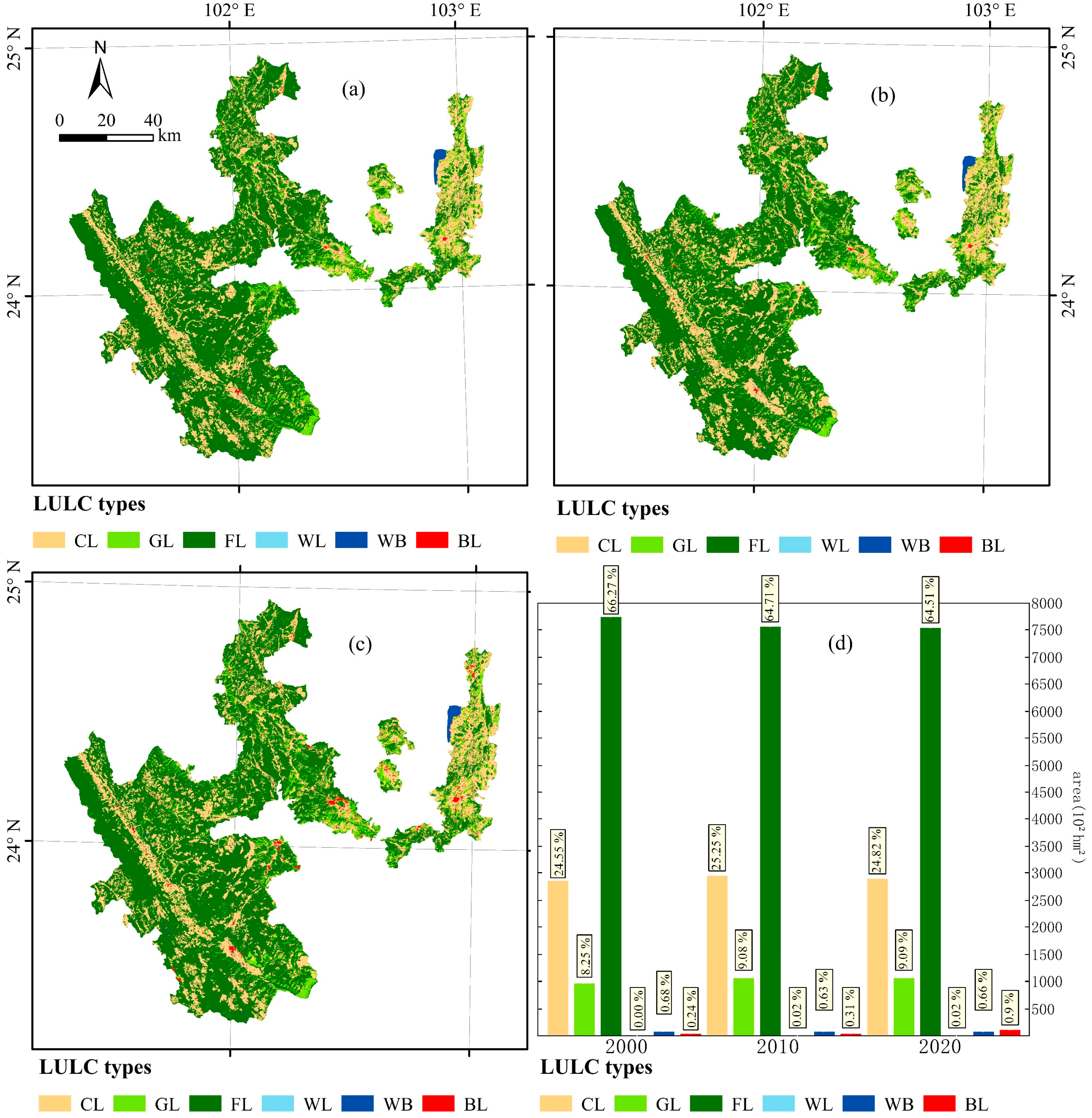
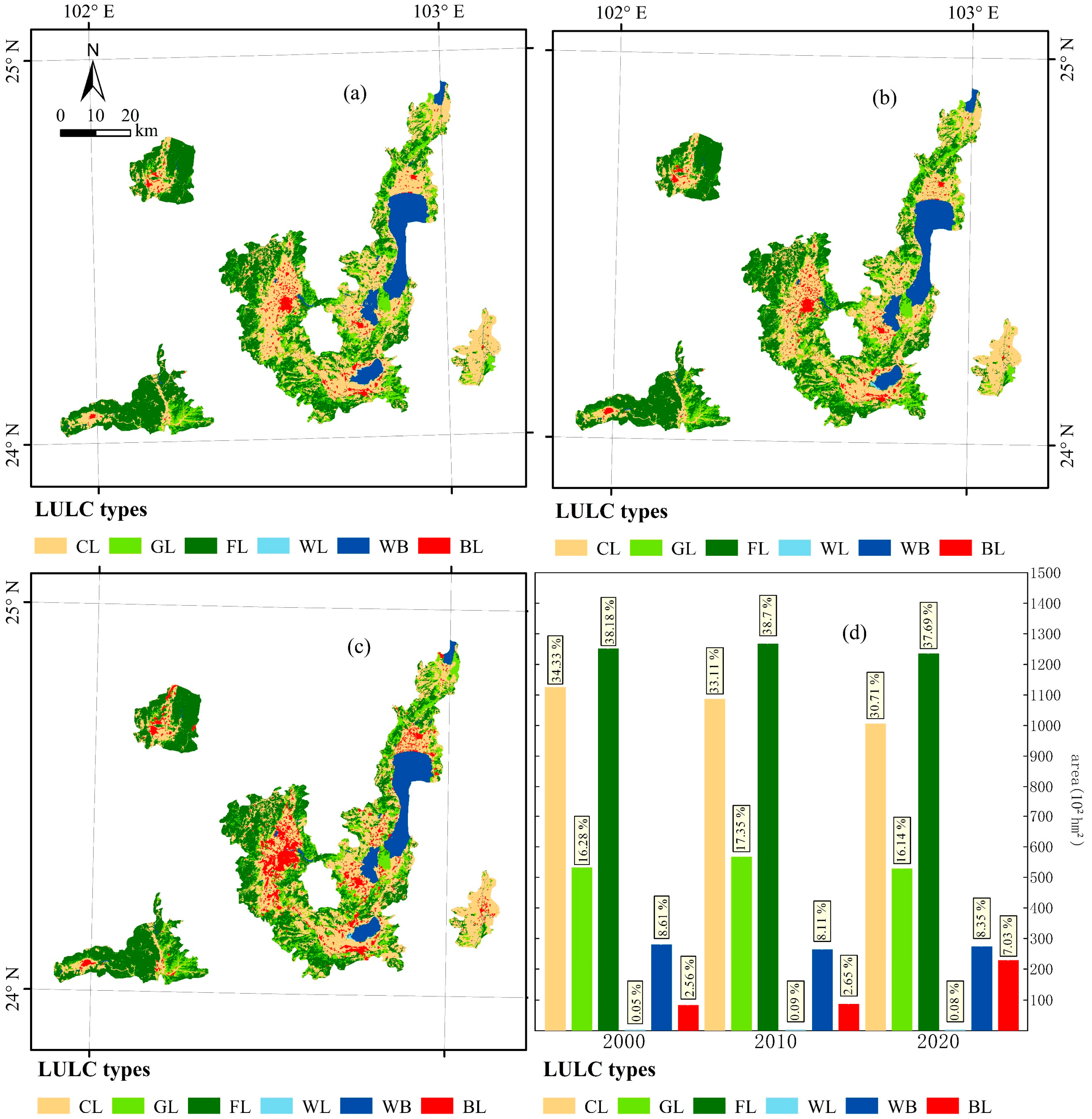

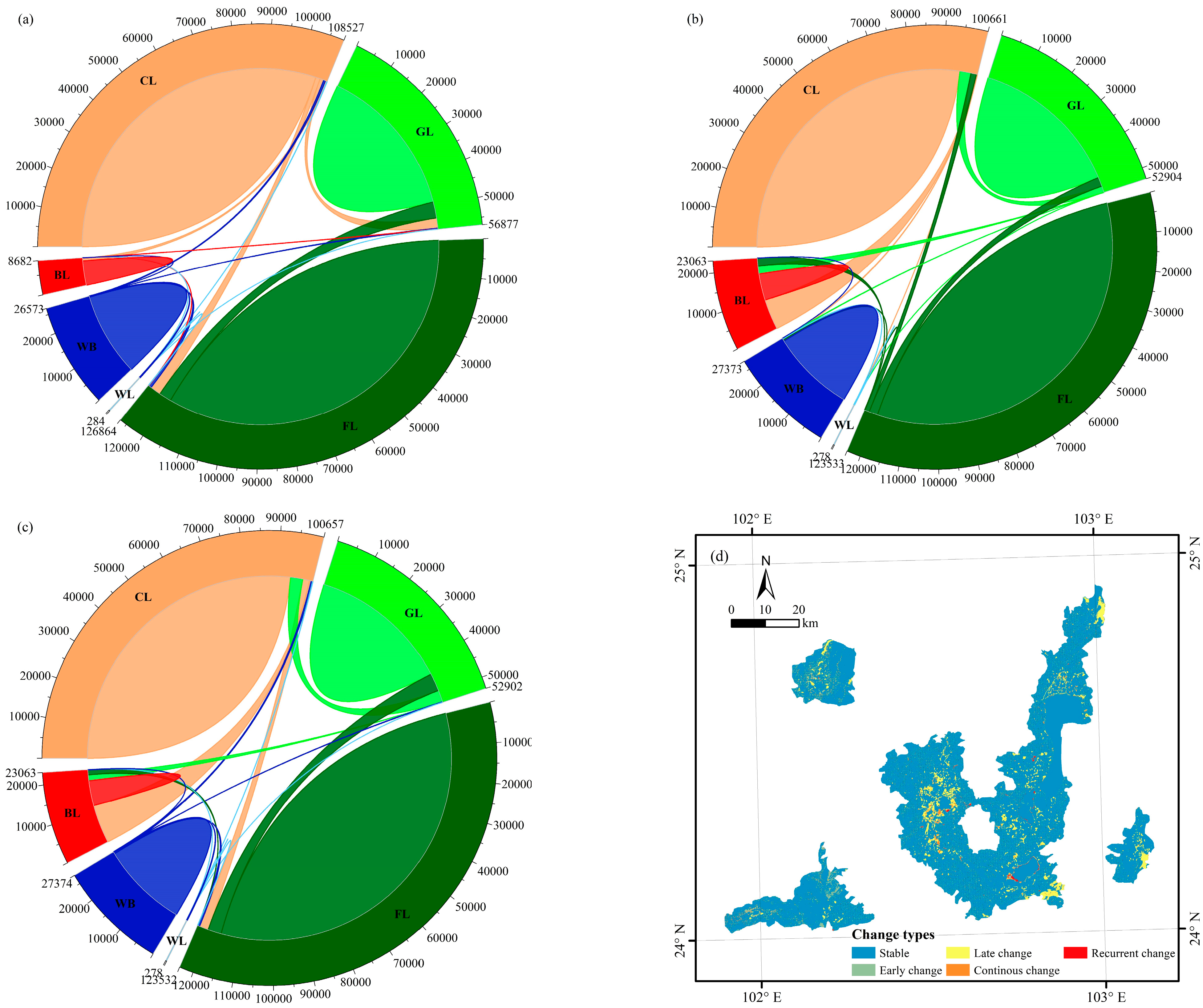
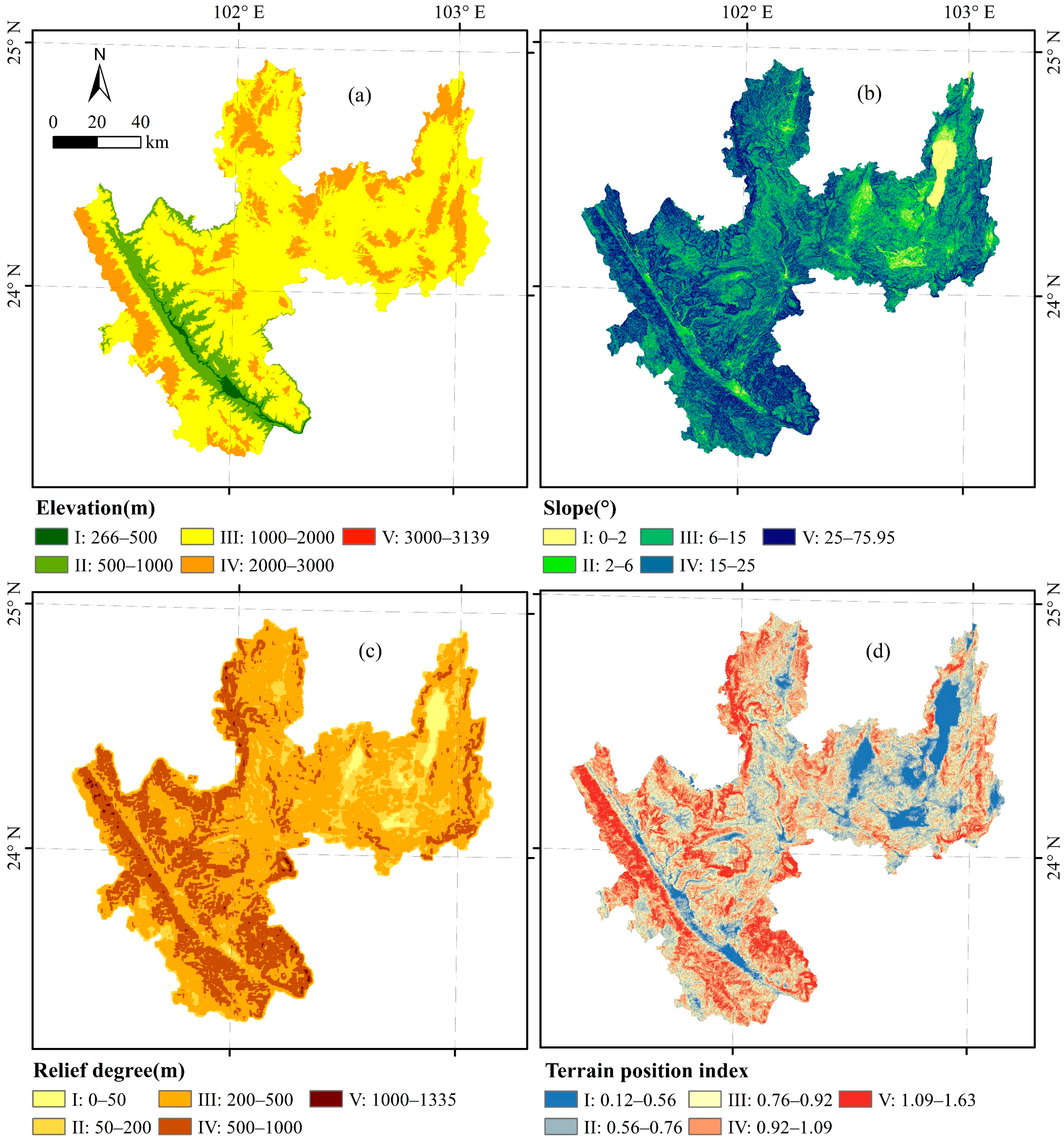
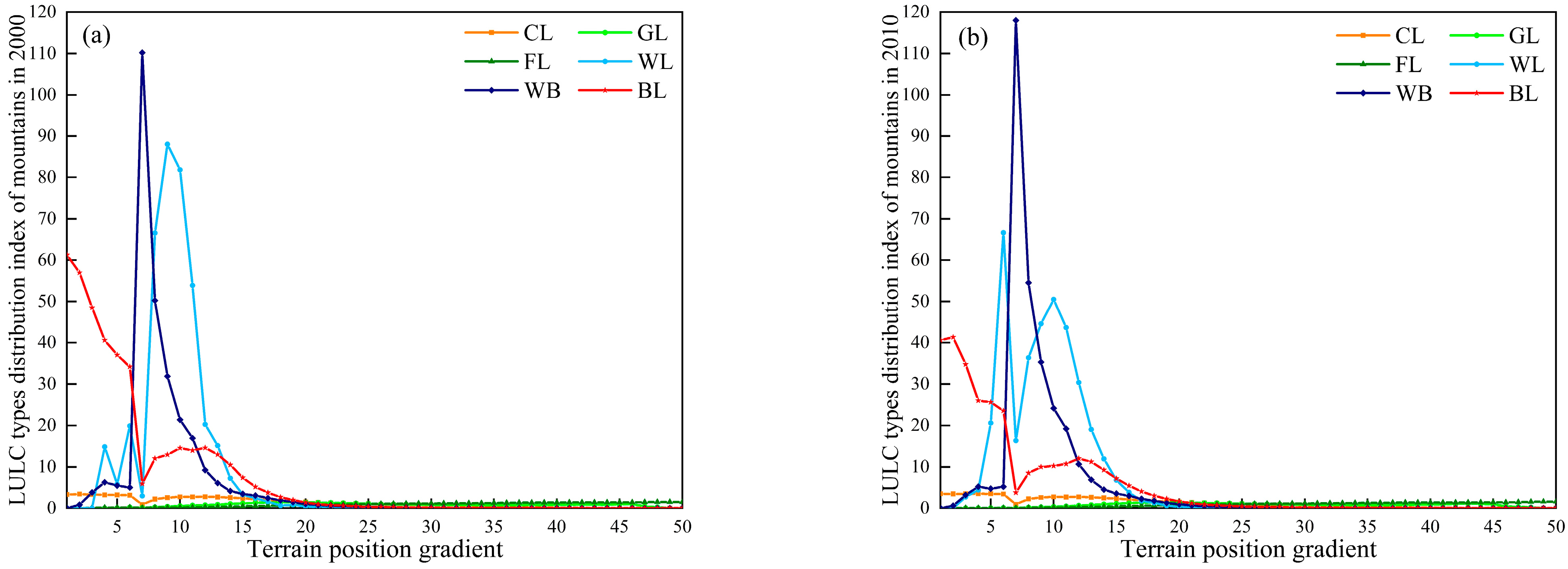
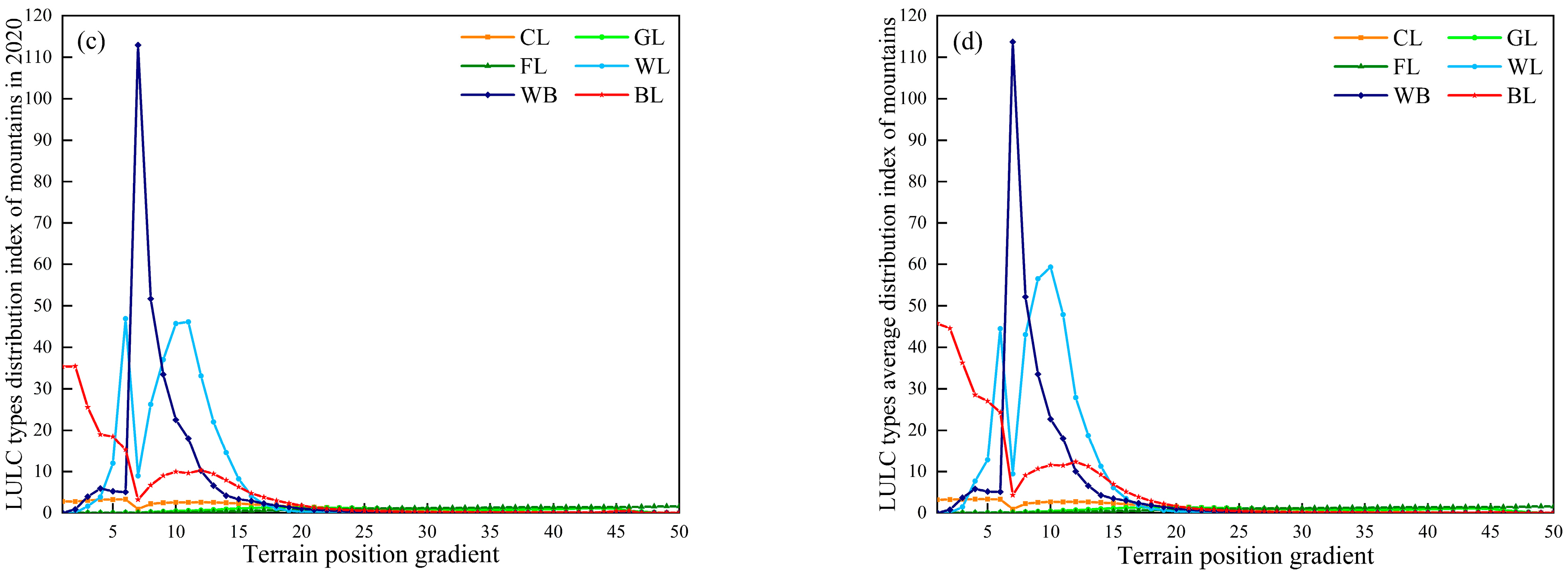
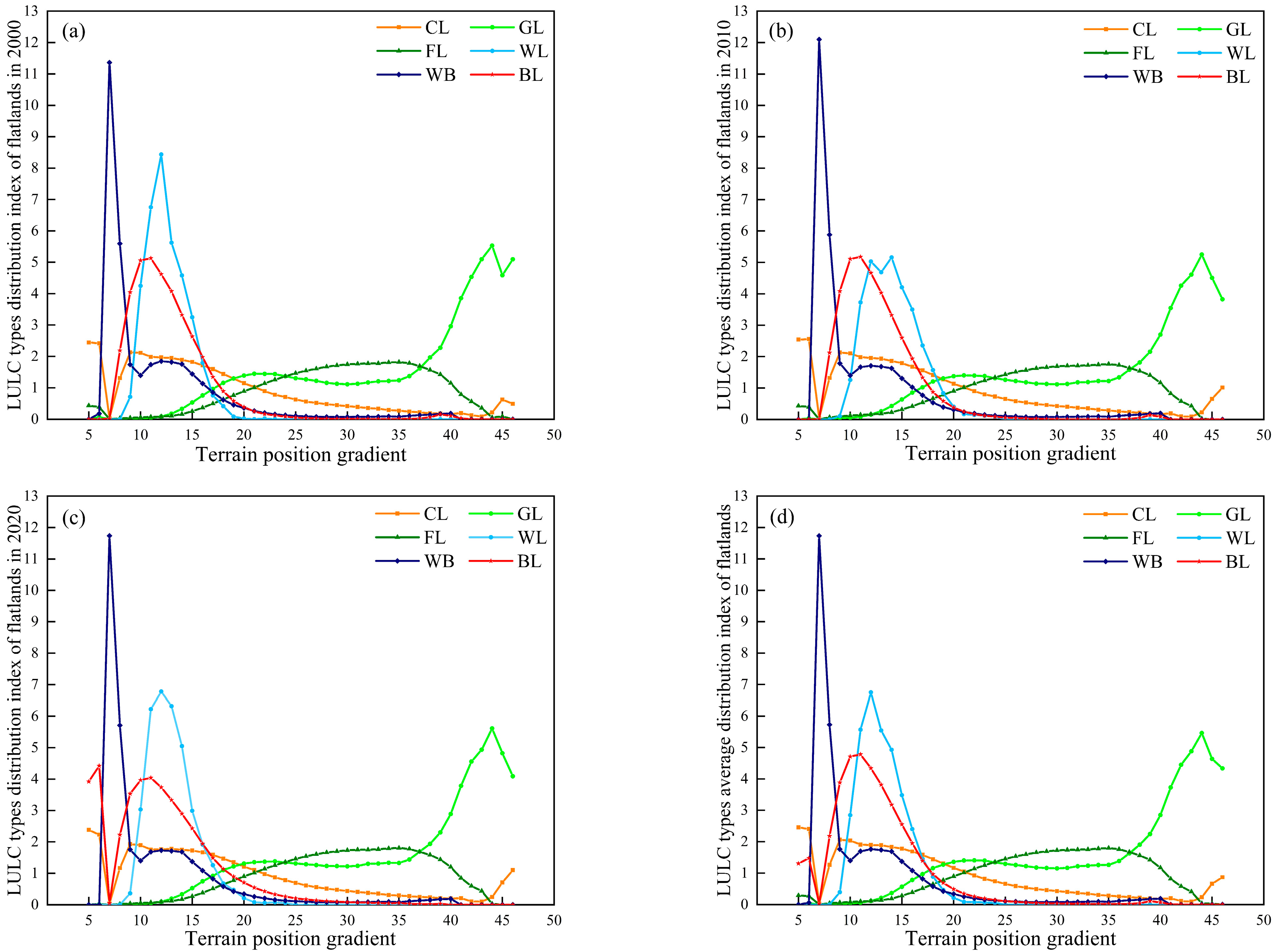
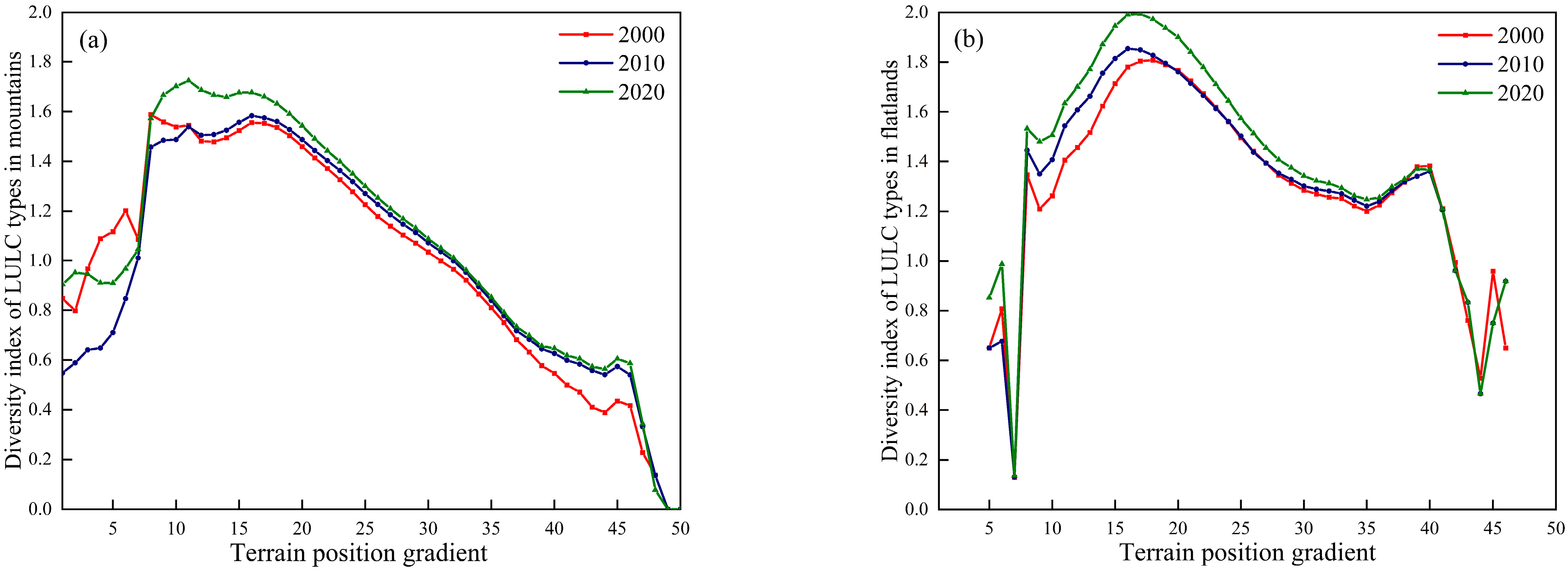
Disclaimer/Publisher’s Note: The statements, opinions and data contained in all publications are solely those of the individual author(s) and contributor(s) and not of MDPI and/or the editor(s). MDPI and/or the editor(s) disclaim responsibility for any injury to people or property resulting from any ideas, methods, instructions or products referred to in the content. |
© 2023 by the authors. Licensee MDPI, Basel, Switzerland. This article is an open access article distributed under the terms and conditions of the Creative Commons Attribution (CC BY) license (https://creativecommons.org/licenses/by/4.0/).
Share and Cite
Wu, L.; Yang, Y.; Yang, H.; Xie, B.; Luo, W. A Comparative Study on Land Use/Land Cover Change and Topographic Gradient Effect between Mountains and Flatlands of Southwest China. Land 2023, 12, 1242. https://doi.org/10.3390/land12061242
Wu L, Yang Y, Yang H, Xie B, Luo W. A Comparative Study on Land Use/Land Cover Change and Topographic Gradient Effect between Mountains and Flatlands of Southwest China. Land. 2023; 12(6):1242. https://doi.org/10.3390/land12061242
Chicago/Turabian StyleWu, Li, Yanjun Yang, Hailan Yang, Binggeng Xie, and Weiqun Luo. 2023. "A Comparative Study on Land Use/Land Cover Change and Topographic Gradient Effect between Mountains and Flatlands of Southwest China" Land 12, no. 6: 1242. https://doi.org/10.3390/land12061242






